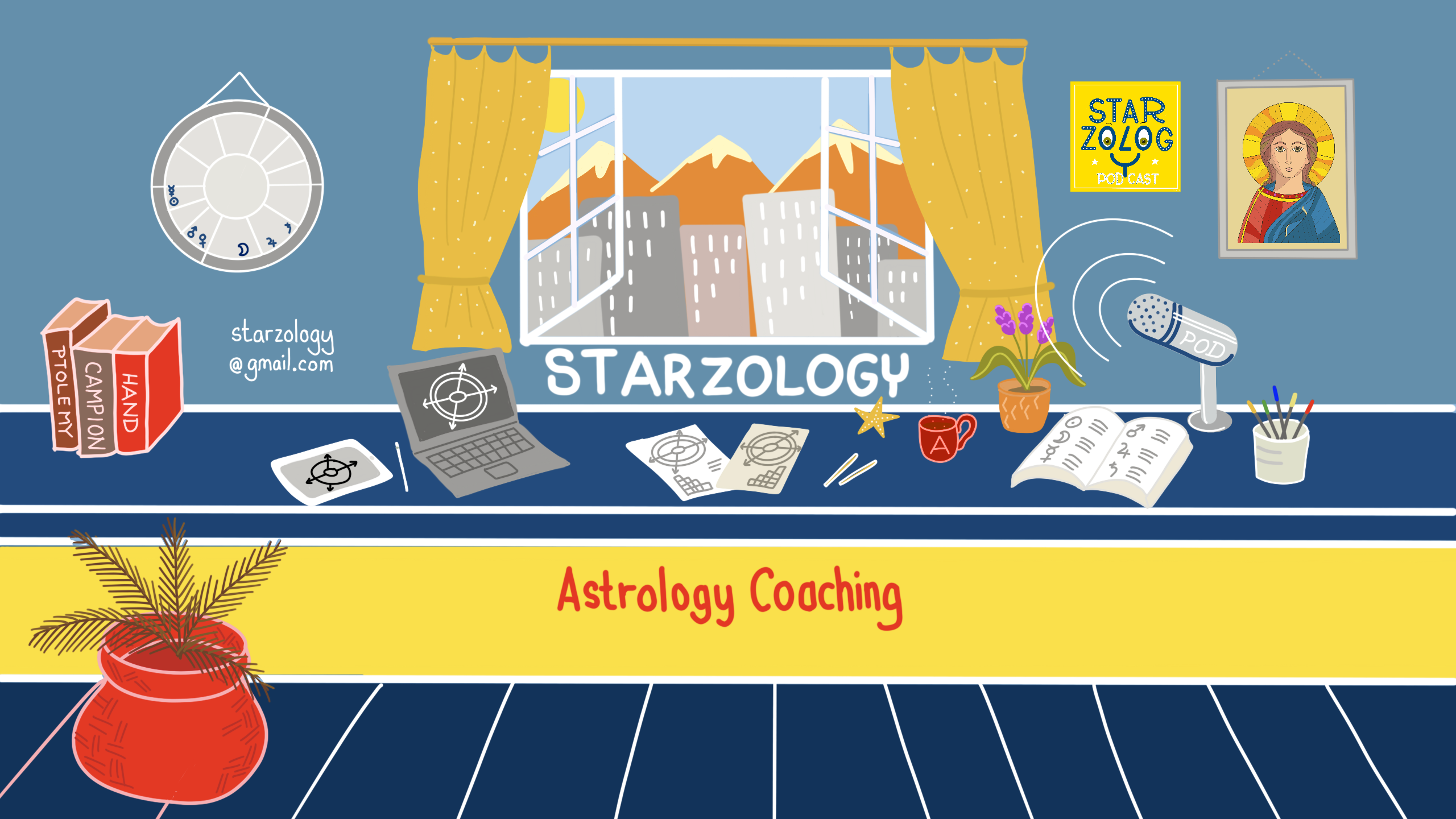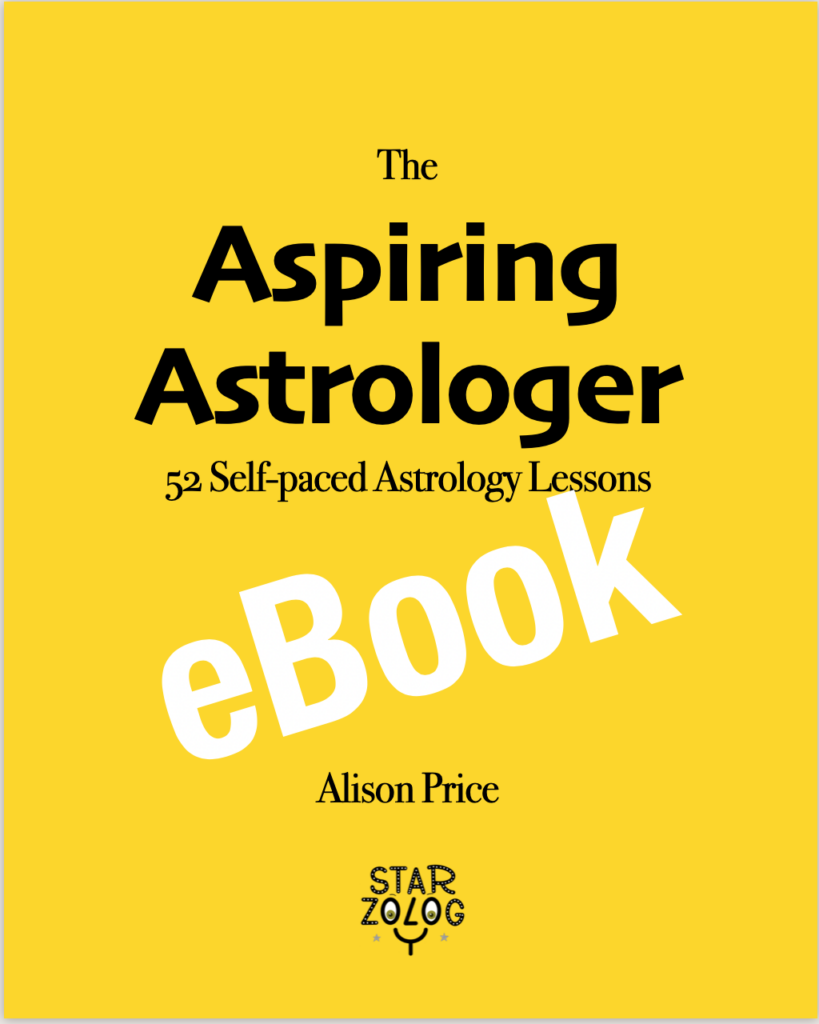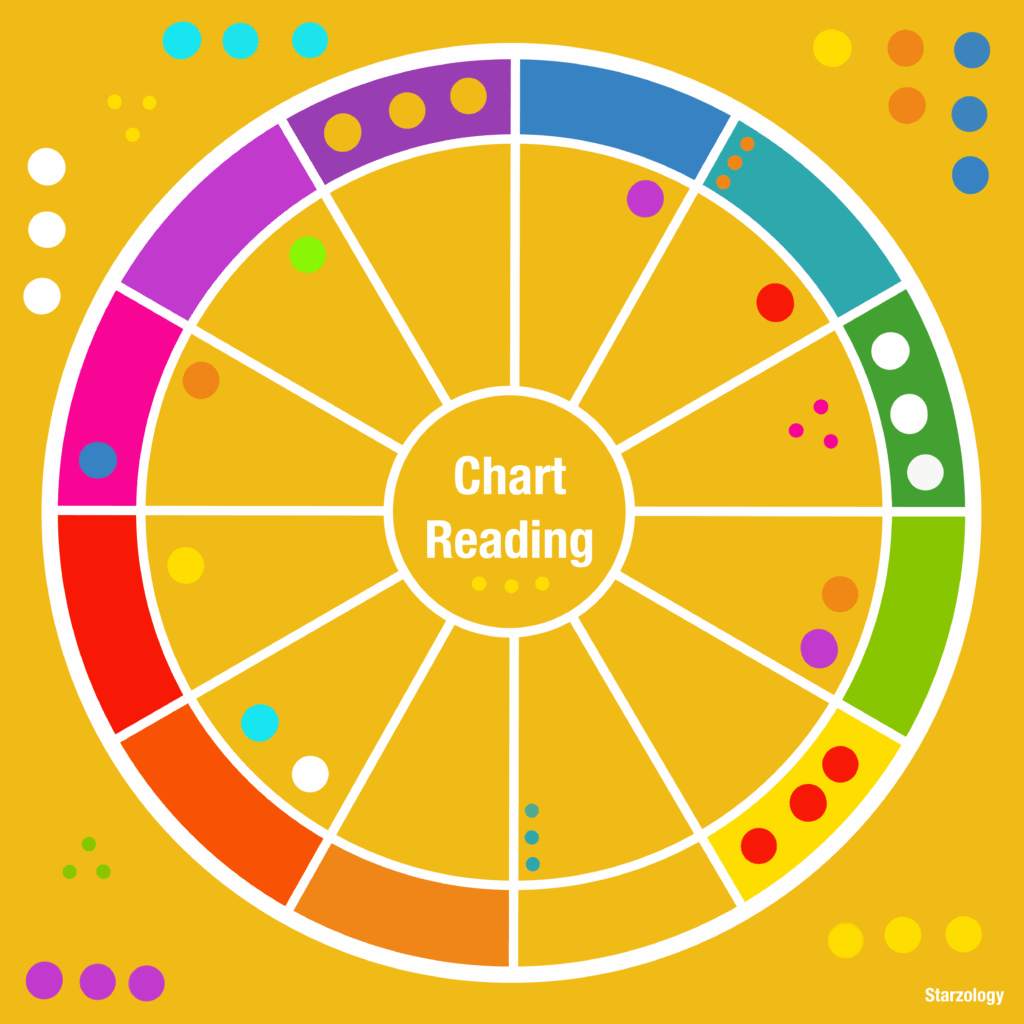The Starzology monthly horoscope overview provides all the ingresses, stations and lunations for each month with a short interpretation.

The Dispositor Tree
Dispositor Trees
Your Chart’s Backstory
There are many techniques that you can use to read a chart and one method that I particularily enjoy is the dispositor tree. Your dispositor tree shows the back story and how the energy is flowing behind the scenes of your chart.
When you draw a dispositor tree, you lift the veil and can see dynamic links joining planets that are not seen on the main chart. This can provide you, as an aspiring astrologer, insights to the person and how they really operate.
A Dispositor Tree
A dispositor tree is a diagram that shows the connections between the planets in a chart. This is done by their essential dignity position and specifically their dignity or rulership of signs.
A planet that rules a sign is the dispositor to any planet in that sign.
Typically, we only use the visible planets for dispositor tree creation as dispositors, although we do add the outer planets, Uranus, Neptune and Pluto into the tree.
Planetary Rulerships
The seven visible planets are; the Sun, the Moon, Mercury, Venus, Mars, Jupiter, and Saturn.
- The Sun rules Leo.
- The Moon rules Cancer.
- Mercury rules Gemini and Virgo.
- Venus rules Taurus and Libra.
- Mars rules Aries and Scorpio.
- Jupiter rules Sagittarius and Pisces.
- Saturn rules Capricorn and Aquarius.
Dispositor trees have a top tier, middle tiers and bottom tiers. The stronger placed planets are at the top of the tree. A dispositor tree can have a little as one planet or as many as ten planets in it.
Trees: 5 Types
There are only five types of dispositor trees and they are:
- Final dispositor trees.
- Mutual reception dispositor trees.
- Single planet in rulership dispositor trees.
- Planet in rulership dispositor trees.
- Committee dispositor trees.
Tiers: Multiple Layers
Within all the five types of trees there are multiple tiers, or layers, which the planets may be on.
The tiers represent some of the planetary hierarchy.
Your tree could have two layers or nine it depends.


How to Draw a Dispositor Tree
Planetary Dispositor
A planet will dispose any planet in its own sign. Planets in the sign of their dignity cannot have a dispositor. Planets that dispose others are drawn vertically. The disposing planet is placed on a level above the planet being disposed.
Example:
Venus disposes Uranus in Libra and Venus is Uranus’ dispositor as Venus rules Libra.


Mutual Reception
Two planets are in mutual reception when they are in the signs of each other’s dignity. Mutual reception relates two planets even if they are not in aspect. Mutual reception joins the pair in a supportive relationship and allows their energies to work together.
Planets in mutual reception are drawn on the same level horizontally. They have equal strength to each other. A double ended arrow joins them.
Example:
The Sun in Cancer and the Moon in Leo are in mutual reception.

Circular Dispositorship
Circular dispositor chains can be found in a chart. Three or more planets can be in a circular dispositorship chain. You still draw them on the same level as they have equal weight in the dispositor tree.
Example:
Mars in Leo, Jupiter in Scorpio, and the Sun in Sagittarius form a circular dispositorship.

Positions: 3 Locations
Each planet may be in one of three positions.
I like to color these locationsl like a traffic light.
The dispositor tree positions are:
- Top (red).
- Middle (amber).
- Bottom (green).

Final Dispositor
A disposed planet will also dispose any planets in its sign. This can form a chain of dispositorships.
In some charts there is a final dispositor. This is the planet which is in its own sign and the dispositor chain falls below.
The final dispositor is a powerful placement for any planet and it should be noted in the chart analysis.
Example:
The Sun disposes Jupiter in Leo, Jupiter disposes Saturn in Sagittarius etc.

Top Dispositor Tree Planet
Position
This planet is only found on the top line of the dispositor tree.
Location Definition
A top planet may link to other planets through links below only. Possible planets in this location are the Sun, the Moon, Mercury, Venus, Mars, Jupiter or Saturn. In other words, the visible planets only. The top planet may only be the final dispositor, a planet in rulership, or a top line mutual reception planet, or a top line committee tree planet.
Interpretation
Top planet location keywords; leads, takes, drives, extroverted, masculine and positive.
Additionally, all top planets have affinities with; the cardinal mode, the angular houses, the Midheaven and the fire element.
The top planet energy is expressed through; taking action, beginnings, the future and being available.

Middle Dispositor Tree Planet
Position
A middle dispositor tree planet is only in the middle of the dispositor tree.
Location Definition
A middle planet must link to other planets through links both above and below. Possible planets in this location are the Sun, the Moon, Mercury, Venus, Mars, Jupiter or Saturn.
In other words, the visible planets only. A middle planet may not be in dignity, but may be in exaltation, detriment, fall, or peregrine.
Planets found in the middle section may also be a “Gateway” planet, which is one with three or more planets below it, so it acts as a gateway for their energies.
Interpretation
The location of a middle planet suggests keywords; does work, gives and takes, a conduit, links, connects. joins and neutral.
Some affinity for a middle planet is indicated with the astrological meanings of; fixed mode, succedent, the air element, nodes, and 1st/7th axis.
The planetary energies of a middle planet are expressed through: Being acted through, within and the present.

Bottom Dispositor Tree Planet
Location
This planet is only in the bottom of the dispositor tree. Location definition; a bottom planet must link to other planets through links above only.
The possible planets in this location may be all the visible planets and outer planets Uranus, Neptune, Pluto, including Chiron, the Asteroids, TNO’s and Eris etc.
A bottom planet may not be in dignity, but may be in exaltation, in detriment, in fall, or peregrine.
Interpretation
Some bottom planet location suggested keywords are; supports, serves, gives, introvert, accepts, feminine and the negative polarity.
Some affinity for a bottom planet is indicated with the astrological meanings of the mutable mode, cadent houses, the IC, the water element, and the northern hemisphere.
The planetary energies of a bottom planet are expressed through being acted upon, endings, the past, and waiting to be asked.


Links: 3 Types
Finally, the links themselves between the planets which form the tree may, or may not, also be aspects.
If a link is also an aspect in the regular sense, (longitudinal or by declination), it adds weight to that connection in the tree and aids the energy flow.

Final Dispositor Tree
Details
Number of planets in a Final Dispositor Tree = ten.
Fnal dispositor trees relate directly to the natal chart’s planetary energies, cohesive energies and works as one unit.
Some suggested keywords for a Final Dispositor Tree structure are; A focused individual, pulls towards the common good, the whole chart is connected, subjective, and works as one “team.”
Internal decisions are made by; dictatorship, president and hierarchical.

Single Planet in Rulership Tree
Only one planet in the single planet in rulership tree.
Single Planet in Rulership Trees relationship to natal chart’s planetary energies.
This is an important planet. It is not integrated and you must carefully consider any aspects to it.
Single Planet in Rulership Tree structures suggested keywords are, the purest form of energy, a wild card, uninhibited, highly specific house meaning and similar to an unaspected planet.
Internal decisions are made by; a wild card and can be the joker?

Planet in Rulership Tree
Number of planets in the tree is less than ten.
The planet in rulership’s dispositor tree’s relationship to the natal chart’s planetary energies; this is a strong placement, always check the link aspects to confirm any connection.
Some keywrords for the planet in rulership dispositor tree’s satructure are; independent and solitary.
Internal decisions are made by the vice president and the second in command.

Gateway Planets
Some planets in a tree will be in the special position of being a gateway planet.
A gateway planet is in a chain and has one planet above and three or more planets below it.
This special planet may (or may not) create a bottleneck for the energy of the planets below and could throttle these celestial urges of the lower planets by restricting the flow to the planet above.

Mutual Reception Tree
In this tree there will be from two to ten planets.
The mutual reception dispositor tree’s relationship to natal chart’s planetary energies suggest there are two teams with related alliances.
This person may be conflicted by the two sides of the mutual reception as the planets below will be on their team.
Mutual Reception Tree structure suggested keywords; objective, dual “sides”, two distinct wings of the personality, and one side may dominate over the other usually the side with more planets and thus weight.
Internal decisions are made by; debate and mutual respect.

Committee Dispositor Tree
The number of planets in the tree will be from three to ten.
Interpretation
Committee dispositor tree’s relationship to the natal chart’s planetary energies; confusion, lack of focus, and always look to any exalted planet for guidance.
Tree structure suggested keywords; multi-dimensional, varied interests, motivations are flexible, and they cannot see the wood for the trees.
Internal decisions are made by democracy and a committee.


Extend Yourself
I believe my role in astrology is to inspire you to stretch yourself. This is why I provide some ideas on how to extend yourself astrologically.
For some first steps with dispositor trees you need a sense of where the planets are by sign and essential dignities.
Watch and Listen
Just to get you in the mood and to get some geneal ideas on dispositor trees please do the following:
Activity
Turn your attention to essential dignity now. In your astrology journal please do the following:
- List the seven visible planets and which signs they rule. You will have seven planets and twelve signs.
- Note any planets in your chart in their own sign. Example: Mercury in Virgo.
- Look for mutual reception pairs. Mutual reception happens when planet A is in planets B’s sign and planet B is in planet A’s sign. Example: Jupiter in Capricorn and Saturn in Pisces.
- If nothing comes up in the previous two bullet points, begin with the Sun and follow the rulership chain back from the Sun’s sign ruler. This is how you will find the committee.
Extend Yourself Further
To really get to grips with dispositor trees you need to draw, analyze and yes, love them.
Start with your own tree, your close families’ trees, friend’s trees and then move onto your client’s trees.
In your astrology journal please do the following:
- Draw your dispositor tree. You can start or some scrap paper to see the final layout then redraw it perfectly in your journal.
- Note how many trees you have. Perhaps you have multiple small independent trees which make up a mini forest.
- Decide which of the five types of dispositor tree you have. Perhaps you have a combination. If you have a final dispositor tree then name the final dispositor. If you have mutual receptions then name the pairs.
- Find any gateway planets and note them.
- Decide how many levels deep (2-9) your tree or trees go.
- Search for any links which are also aspects. Write the aspect glyph next to the link. Here you can include the Ptolemaic aspects and aspects of declination (the parallels and contra-parallels).
- Highlight the chart rulers in yellow. This makes them easier to see.
- Spend some time studying the tree, its hierarchy and general shape. In time this step can become as a meditation as well.
- Interpret your tree by discussing each point from above. Write at least 100 words for each point (total 700 words).
- Reflect on your dispositor tree. Was it easy to draw? How does if feel? What is the general shape? Which planets stand out? Are there any planets that have come forward which are a little surprizing for you? Do you need to go back a learn the rulerships again? Does your tree align with what you already know about the basic interpretation of your chart? If not, how can you bring focus to the dominant planets and themes brough up in your dispositor tree in the future? Which planet complex will you research further in your chart?

Pin this to read later
Author Bio
Alison Price: Astrology Coach
Alison wants to help you uncover your individual creativity and lead a fulfilling life using your own astrology. She shares her wisdom from the heart with a touch of humor.
Learn more about Alison’s journey.
If you’d like to get in touch with Alison, you can reach out to her via email at starzology@gmail.com.
More Articles
If you enjoyed this post, you may like some more astrology related articles from our blog.

This Month’s Horoscope Overview

2nd House Planets
Author: Alison Price - Updated: March 2025 Planets in the Second House Active Tenants The placement of planets in the second house will always influences your relationship with money, possessions, and personal values. Each planet brings its own energy, to shape...

Midpoint Composite Charts
Learn about MIDPOINT COMPOSITE CHARTS in relationahip astrology. Discover how they are calculated and when to use them.

Sunsetting the Paid Starzlife Newsletter
Sunsetting the Starzlife Paid Newsletter Thursday Edition After nearly a year, I’ve decided to sunset the Starzlife paid newsletter. This means the free Starzology newsletter will continue to go out every Sunday, but the exclusive Thursday edition for paid subscribers...





